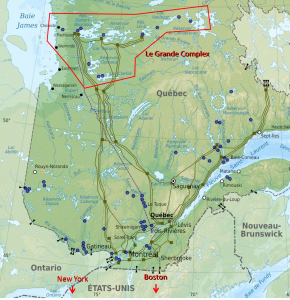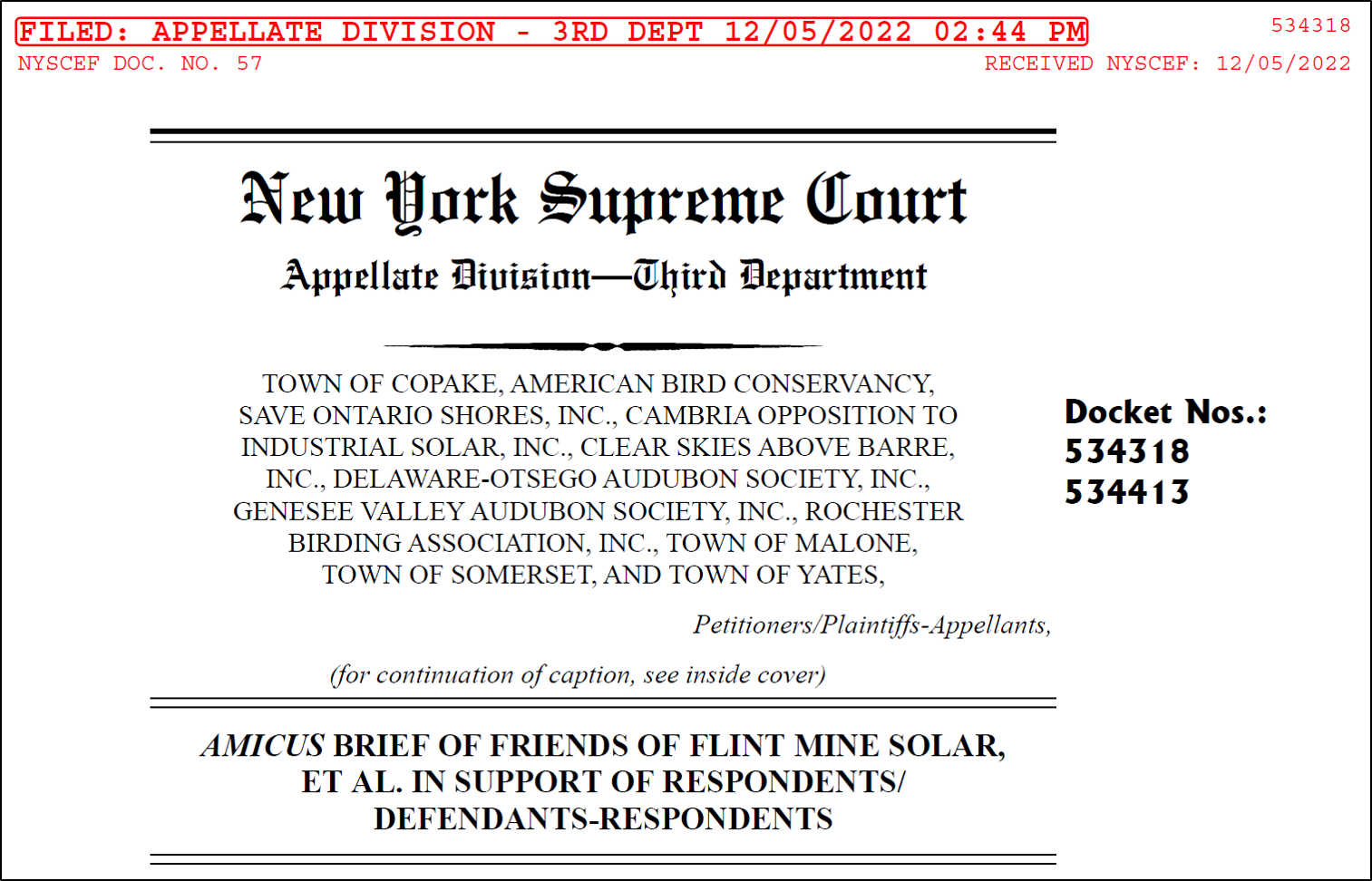by Justin Gundlach

Three weeks ago, at the invitation of the Canadian Consulate and Hydro Québec, I traveled to see two enormous hydropower facilities. One of them, La Grande 2-A, is part of the La Grande Complex of dams, turbines, and electricity substations located in the James Bay region (see map at right). Getting there required a two-hour northward flight from Montreal (the road trip would take about 15 hours). The other facility, the Beauharnois Generating Station, is located just outside Montreal. I was one of a number of academics, economists, and attorneys that Hydro Québec and the Canadian government thought would be interested to know more about Canadian hydropower—in particular, its potential to meet demand in the New York and New England regions for large volumes of reliable, low-emissions electricity.
Even those who don’t want to see more imported Canadian electricity would have to concede that electricity policy and operations in Québec, New England, and New York are compatible. First, all three regions assign prices to the greenhouse gas emissions from their electricity sectors. Second, there is excess supply in Québec and robust demand for new low-emitting capacity in New York and New England. That demand is the result of some of the highest electricity prices in North America, ambitious state-level greenhouse gas emissions reduction goals, and growing numbers of nuclear power plant closures throughout the region. Furthermore, whereas Québec experiences peak electricity demand in the winter (most heating there is electric), New England and New York experience peaks in the summer (cooling here is electric), meaning that the regions would seldom compete for the output of Hydro Québec’s reservoirs.
The only missing piece of the puzzle—or circuit, if you like—is transmission capacity. Existing interconnections allow Hydro Québec to send about 30 terawatt hours (TWh) of hydroelectricity south each year. The company would like to supply twice that amount (it won’t reveal specifics about its maximum current or future potential capacity). Read on below the jump for more background about Canadian hydropower, how state laws in the U.S. are driving demand for such resources, the status of transmission line plans, the players and arguments involved, and a short description of how federal law bears upon the development of cross-border transmission capacity.
Between the 1930s and the 1980s, Hydro Québec, the region’s vertically integrated electric utility, built a number of large dams. All told, it can now generate about 200 TWh of electricity each year—about 23% more than was consumed in New York State in 2015—and is adding to that amount by developing additional capacity and finding ways to squeeze more out of existing facilities, for instance by adjusting the angles of turbine blades. Large volumes of cheap electricity have kept electricity rates in Québec persistently low, leading businesses and residents to rely almost entirely on electricity to operate and heat their buildings. This in turn means that Québec’s greenhouse gas emissions come almost entirely from its transportation and industrial sectors. (Notably, if the region achieves its ambition of quickly replacing its existing passenger vehicle fleet with electric vehicles, it would thereby soak up at least some of Hydro Québec’s excess capacity.)
This resource is “closer” than its physical distance suggests: although it is hundreds of miles from load centers in New England and New York, it transmits power at light speed and can ramp up and down as quickly as a natural gas facility, which means it can supply—or stop supplying—power with just a few minutes’ notice. This feature, as Hydro Québec is eager to broadcast, can make Hydro Québec’s network of large hydroelectric facilities useful as a backup for variable renewables like wind and solar on the U.S. side of the border.
Ready access to Canadian hydropower is thus an enticing prospect for states that are committed to developing large volumes of solar and on- and off-shore wind, but cannot develop renewable capacity fast enough to offset closing nuclear plants and stave off incursions by natural gas power plant developers. Those states’ commitments arise from three legal bases. First, all of them participate in the Regional Greenhouse Gas Initiative, which assigns a price to carbon emissions from large power plants. Second, all have adopted some form of Renewable Portfolio Standard (RPS), which requires retail utilities to purchase either renewable power or Renewable Energy Credits. The third category is a mix of diverse, direct forms of renewables promotion, such as power purchase agreements and offshore wind development.
The bottleneck preventing low-emissions power from flowing south from Quebec’s undersubscribed hydropower facilities is transmission capacity. This bottleneck is not new and several proposed cross-border transmission projects have been working their way through regulatory approval processes for years. Two of these projects, the Champlain Hudson Express and the Northern Pass Project, are nearing final regulatory approval though are not yet under construction. The first of these would provide about 1,000 megawatts of capacity via a 330-mile path from the Canadian border to New York City, all of it either on the beds of Lake Champlain and the Hudson River or underground. The Northern Pass line would carry 1,090 megawatts of capacity 190 miles from the border to an existing substation in Deerfield, New Hampshire. Both lines would use high-voltage direct current (HVDC) lines, which transmit more efficiently than alternating current lines. Both would be expensive to build: the projects’ developers (who have a vested interest in the numbers being low) estimate $2.2 billion for the Champlain Express and $1.6 billion for the Northern Pass. Notably, both are also “merchant lines,” meaning that they are not guaranteed recovery of their costs from ratepayers via regional wholesale markets’ regulatory authorities. This makes the preferences of the state-level actors that will negotiate agreements with the risk-taking transmission line developers even more important.
So why not build the lines and import more hydropower? Electricity sector interests, unions, environmentalists, and politicians all have ready answers to these questions.
Domestic natural gas and nuclear facility owners and developers stand firmly against imported hydro, and argue that U.S. ratepayer dollars should not be exported when they could pay for more jobs at home. Several labor unions echo that point. Wind and solar facility owners and developers are less averse, not because they are indifferent to competition but because legislators and regulators in New England and New York have been persuaded to exclude large scale hydro from the renewables category, such that Hydro Québec may not sell Renewable Energy Credits (RECs) to domestic utilities as wind and solar facility owners do.
Environmentalists are split. Hydro Québec’s dams block rivers or convert river valleys into reservoirs with harmful effects on the local environment. Transmission lines either mar landscapes or must be buried, which roughly doubles their cost. As for climate impacts, artificial reservoirs emit non-negligible volumes of methane and carbon dioxide for a number of years after their creation, but reservoir-specific emissions rates remain the subject of dispute—Hydro Québec’s website states that the cold temperatures where it operates serve to reduce the methane released relative to amounts seen in warmer regions. Some environmentalists, led by the Sierra Club, argue that in addition to these environmental harms expensive transmission lines would siphon money away from investments in energy efficiency and domestic wind and solar. Other environmental groups, however, emphasize the potential climate benefits of hydro’s relatively low emissions profile and ability to keep new natural gas facilities at bay.
Politicians are also involved, of course. Canadian hydropower provides one partial answer to the question of how New York might stay on track to meet its electricity sector emission reduction goals after the closure of Indian Point nuclear power station in 2021. The situation is similar in New England, where the race to replace coal and aging nuclear capacity is being run by domestic natural gas and renewable developers. Massachusetts’ legislature intervened in August 2016 by adopting legislation that directs the state’s Department of Energy Resources to issue an RFP in 2017 for 1,600 MW of long-term clean energy capacity and would allow large-scale hydropower resources to bid.
Federal law plays a limited role in de-bottlenecking this transmission corridor.
Transmission lines like those that would carry Canadian hydropower south of the Canadian border must navigate a thicket of regulations relating to environmental impacts and issues of cost allocation. The processes involved in implementing all these legal requirements ensure that stakeholders have opportunities to raise concerns and suggest changes to projects in order to avoid or mitigate adverse impacts. For instance, a coalition of environmental groups struck an agreement with Champlain Hudson line’s developer to revise its route to avoid sensitive ecosystems and to create a $117 million environmental trust fund that would be available to remedy environmental damage done during or after project development. But those processes also create numerous opportunities for opponents to try to slow down or impede project planning and approval—in good faith or otherwise.
Congress and the Federal Energy Regulatory Commission (FERC) recognized years ago that the future of America’s electricity grid would involve linking transmission lines to new generation—especially generation located in places where the sun shines or the wind blows steadily. The Energy Policy Act of 2005 gave the Department of Energy and FERC “backstop” siting authority to authorize transmission projects located in National Interest Electricity Transmission Corridors (NIETCs) even if states tried to slow-walk those projects’ approval. (However, courts have since largely nullified this authority and Congress has not restored it.) And in 2011 FERC adopted Order 1000, which gives the regional organizations that manage transmission lines more authority to coordinate planning and to allocate cost recovery regionally. Linking load centers in New England or New York to hydropower generated north of Montreal would require overcoming a situation in which multiple public and private entities tally benefits and costs from their particular perspectives, such that decisionmakers in fragmented jurisdictions can confidently endorse or walk away from a solution regardless of whether it would serve the interests of the region as a whole. This is exactly the set of circumstances that Congress and FERC envisioned as getting in the way of desirable transmission development. However, these federal legal encouragements have done little to speed the process of transmission line approval or development up to the Canadian border, and the fact that lines currently being developed are merchant lines is especially telling. That is, it makes clear that developers would rather run the financial risk of wholly private contracting than endure the regulatory process involved in securing guaranteed compensation through wholesale market regulatory mechanisms.


